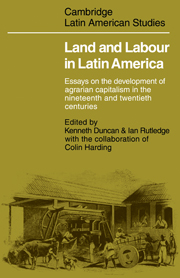 Land and Labour in Latin America
Land and Labour in Latin America Book contents
- Frontmatter
- Contents
- List of tables
- List of figures
- List of maps
- Acknowledgements
- 1 Introduction: patterns of agrarian capitalism in Latin America
- PART I THE TRANSITION FROM TRADITIONAL HACIENDA TO CAPITALIST ESTATE
- PART II THE DEVELOPMENT OF A PLANTATION ECONOMY WITH LABOUR RECRUITMENT FROM HIGHLAND PEASANT COMMUNITIES
- PART III THE DEVELOPMENT OF COMMERCIAL AGRICULTURE USING EUROPEAN IMMIGRANT LABOUR
- PART IV THE TRANSITION FROM SLAVE PLANTATION TO CAPITALIST PLANTATION
- 14 The consequences of modernization for Brazil's sugar plantations in the nineteenth century
- 15 From banguê to usina: social aspects of growth and modernization in the sugar industry of Pernambuco, Brazil, 1850–1920
- 16 The evolution of rural wage labour in the Cauca Valley of Colombia, 1700–1970
- 17 The post-emancipation origins of the relationships between the estates and the peasantry in Trinidad
- PART V POSTSCRIPT
- Glossary of Spanish and Portuguese terms used in the text
- Weights and measures
- Notes on contributors
- Indexes Subjects
- Authors
16 - The evolution of rural wage labour in the Cauca Valley of Colombia, 1700–1970
Published online by Cambridge University Press: 07 May 2010
- Frontmatter
- Contents
- List of tables
- List of figures
- List of maps
- Acknowledgements
- 1 Introduction: patterns of agrarian capitalism in Latin America
- PART I THE TRANSITION FROM TRADITIONAL HACIENDA TO CAPITALIST ESTATE
- PART II THE DEVELOPMENT OF A PLANTATION ECONOMY WITH LABOUR RECRUITMENT FROM HIGHLAND PEASANT COMMUNITIES
- PART III THE DEVELOPMENT OF COMMERCIAL AGRICULTURE USING EUROPEAN IMMIGRANT LABOUR
- PART IV THE TRANSITION FROM SLAVE PLANTATION TO CAPITALIST PLANTATION
- 14 The consequences of modernization for Brazil's sugar plantations in the nineteenth century
- 15 From banguê to usina: social aspects of growth and modernization in the sugar industry of Pernambuco, Brazil, 1850–1920
- 16 The evolution of rural wage labour in the Cauca Valley of Colombia, 1700–1970
- 17 The post-emancipation origins of the relationships between the estates and the peasantry in Trinidad
- PART V POSTSCRIPT
- Glossary of Spanish and Portuguese terms used in the text
- Weights and measures
- Notes on contributors
- Indexes Subjects
- Authors
Summary
The paradox suggested by the term ‘Andean tropics’ is indicative of the singularity of landlord-peasant relationships as they have evolved over the past four centuries in the Andean drainage basin of the Río Cauca, as in the whole of Colombia. This country was the chief gold producer of the Spanish American empire and had the highest Afro-American population of the Spanish American mainland. Its social and economic history has been firmly etched by the early numerical ascendancy of free ‘mixed bloods’ and the political and property relationships they represented. Nineteenth-century Colombia was unique, even for Latin America, in the diversity of its regionalism, factionalism, and caudillismo. Added to this, the fanatical separation of the entire society into two monopolistic political parties, not dissimilar to religious war machines, has from 1840 until very recently set it apart from the other Latin American republics.
Its composite character brought together all the features that were found separately in the other Latin American colonies. Its topography owes everything to the splayed backbone and dissected valleys of the Andes; yet African slaves, not Andean Indians, formed the basis of its wealth. But in contrast to the other slave colonies, it was not the intensive cultivation of tropical crops on large-scale plantations conveniently located near the coast that made the slaves necessary: rather, it was an economy based on mobile, scattered, and small-scale alluvial gold-mining camps. In short, it was both Caribbean and Andean in its component elements, but unique in its synthesis.
- Type
- Chapter
- Information
- Land and Labour in Latin AmericaEssays on the Development of Agrarian Capitalism in the nineteenth and twentieth centuries, pp. 397 - 434Publisher: Cambridge University PressPrint publication year: 1978
- 2
- Cited by


